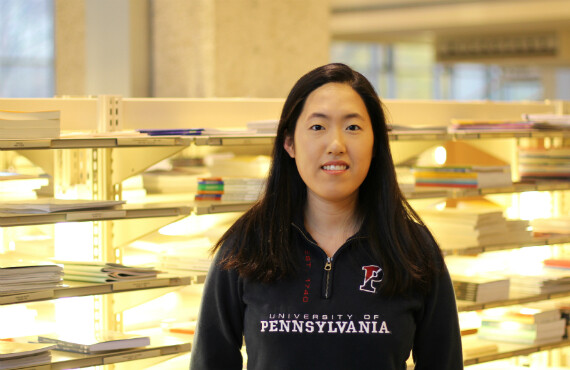Penn Senior, a Future Doctor, Looks to Medicine’s Past for Insights
By Christina Cook
University of Pennsylvania senior Ellen Kim didn’t want to head to medical school next year without taking full advantage of two particular Penn strengths: the interdisciplinary tradition that characterizes its academic environment and the undergraduate research opportunities.
Kim’s research project, which began this summer, braids together history, architecture and mental illness.
“Those are fields that I’ve never really looked at before but was always fascinated by,” she says.
The flames of her fascination were fanned by the Medicine in History course she took for her health and societies major, taught by David Barnes, associate professor of history and sociology of science.
“I remember doing a reading assignment for the class and coming across the phrase ‘architecture of hospitals’ in one of the footnotes. I thought that was really interesting and kept it in the back of my mind.”
Midway through the semester, Barnes’ class visited the Pennsylvania Hospital archives to perform historical analyses on patient records for an assignment. Kim says it was there “where I was introduced to historical research, and what you’re faced with when you go to archives.”
When it came time to plan her thesis, Kim says she had two avenues.
“One was to do something I’d never done before, and the other was to do medical-based or more scientific research.”
So, after weighing her options, the University Scholar and Benjamin Franklin Scholar from Lexington, Mass., took the road less travelled by pre-med students, and the rest is history — the history of medicine, to be exact.
Kim decided that her thesis would be a great chance to learn about this interdisciplinary weave of topics she found so compelling, and she thought this last year at Penn would be the perfect time to pursue it, given the support she has through the University Scholars program.
She sees the University Scholar lunch presentations as weekly opportunities to engage with students and faculty from across the University.
“When there’s a Q&A session after my research presentation, for example, someone from engineering may ask me a question that frames my work in a different light and enables me to think about it from a perspective I never would have thought about on my own.”
Kim recalls meeting Robert St. George, an associate professor of history, at one of the lunches while she was formulating her thesis topic.
“We started talking and, as it turned out, he knew a lot of the people I was reading about in my secondary literature. He gave me a lot of great advice.”
Kim’s project also led her to seek advice from faculty in other schools on campus.
“It really took me around to almost every single school at Penn. It’s incredible how you can take this one topic and go to so many different people who have something insightful and helpful to add. I’m surrounded by all these wonderful faculty who are immersed in such interesting topics and who know so much; I really had to take advantage of that.”
The direct result of gathering input from faculty across the disciplines is a more robust research project, which Kim describes as “the little threads that I’ve picked up from different people that have come together.”
Kim says that, when she first began her historical research, she wasn’t sure exactly what she was looking for, beyond answers to questions that cohered around two topics: the many mental asylums being built in the United States in the 19th century and the accompanying idea of architecture as a possible avenue of treatment.
“It was a little daunting when I started out because I had never done historical research on my own before, so after about a week in the archives I emailed Dr. David Barnes and Dr. Aaron Wunsch and said I had all these photos and documents and no idea what to do with them. They both said, ‘Well, this is what I would do if I were in your shoes,’ and that was really helpful.”
As the course of Kim’s research unfolded, her focus changed. She describes her final thesis topic as “the broad-scale social changes happening at the end of the 19th century” through the lens of the gymnasium building on the Friends Hospital campus in North Philadelphia.
Wunsch, assistant professor of historic preservation in the Penn School of Design and Kim’s thesis advisor, explains how she uses the 1880s gym “to tell a broader story of the ways in which such institutions moved from more passive forms of recreation before the Civil War to more active, athletic ones as part of a larger turn from mind to body in the early age of ‘muscular Christianity.’”
Wunsch says that, “as an architectural historian, I think Ellen's project is exciting because it doesn't treat the original intentions of her institution's founders as the end of the story. Instead, those intentions become a foil for understanding the post-Civil War history of one of the most innovative and important therapeutic institutions in the U.S.”
Kim feels confident that her research will enhance her future career in medicine.
“The most direct way that studying the history of medicine fits into practicing as a physician is by giving me an invaluable perspective on medicine, in terms of how medical practice has evolved to its current state.”
She feels that this perspective, first learned in David Barnes’ history of medicine class, has given her “a greater awareness of what the field of medicine is.
“I'm hoping to continue my research in the history of medicine through medical school,” Kim says. “There are a lot of paths I may take, but my ideal situation would be to pursue a Ph.D. in the history of medicine and combine teaching and research in this field with practicing as a family physician.”








